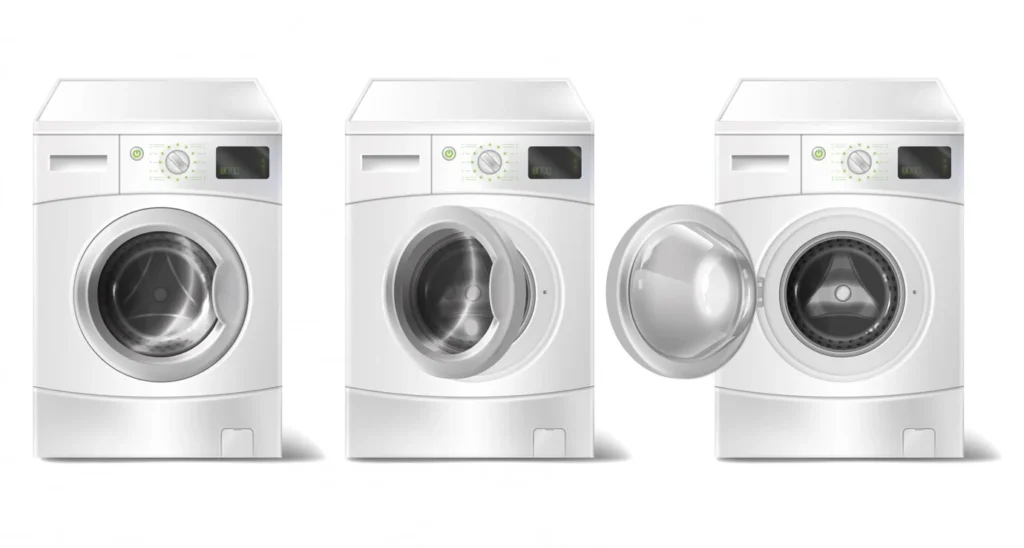
By Admin
Washing Machine Cycles explained for beginners – Learn what each setting does and how to choose the right cycle. Get expert insights and avoid common mistakes. Find the best washing machine repair services for support.
Washing machines have become an indispensable part of modern households, yet many people still don’t fully understand the range of washing machine cycles available. From regular to delicate, heavy-duty to quick wash, each setting serves a specific purpose. Knowing how to use them correctly can save time, and energy, and even extend the life of your clothes.
This beginner-friendly guide explains the most common washing machine cycles, offers tips on when to use each one, and shares best practices for getting the most from your washer. Whether you’re doing laundry for the first time or simply want to improve your routine, this guide will help you make smarter choices and avoid common mistakes.

Using the wrong cycle can lead to several issues, including:
Damaged or worn-out clothes
Inefficient energy and water use
Longer laundry times
Increased risk of appliance malfunction
By choosing the correct washing machine cycles, you can:
Reduce electricity and water bills
Keep your clothes looking better, longer
Lower the risk of breakdowns and the need for repair
Make the most of your machine’s features
Most modern washing machines come with a variety of cycle settings. While names may differ by brand, these are the core cycles you’ll find on most machines.
Best for everyday fabrics like cotton, t-shirts, jeans, and linens
Typically uses warm water with high-speed spins
Average cycle time: 30 to 60 minutes
This is the standard setting for most daily loads and provides a solid clean without being too harsh.
Ideal for silk, lace, lingerie, or lightly soiled clothes
Uses cold or lukewarm water with slow spin speeds
Shorter cycle to reduce wear and tear
Designed to handle delicate fabrics with care, this cycle prevents stretching, tearing, and color fading.
Best for towels, bed linens, workwear, or heavily soiled items
Uses hot water and aggressive agitation with a longer cycle time
High-speed spin for faster drying
This is the go-to for tough stains or large, dense fabrics that need extra attention.
Meant for lightly soiled clothing or small loads
Typically lasts between 15 to 30 minutes
Uses warm water and medium spin speed
Ideal when you’re short on time and just need to freshen up your clothes quickly.
Designed to conserve energy and water
Uses lower water temperatures and longer run times
Best for lightly soiled garments
While the cycle takes more time, it’s a great way to reduce your carbon footprint and save on utility bills.
Intended for baby clothes, bedding, or garments that require deep cleaning
Uses extra-hot water and longer cycle durations
Helps eliminate bacteria and allergens
This cycle is especially helpful for households with young children or allergy-sensitive individuals.

Choosing the right cycle doesn’t have to be complicated. Here’s a quick breakdown to help you decide based on your laundry needs:
Fabric type
Cotton, denim: Use the Normal or Heavy Duty cycle
Delicates: Opt for the Gentle or Delicate cycle
Synthetics: Use a low-temperature setting, often labeled as “synthetic” or “casual”
Soil level
Light stains: Quick Wash is sufficient
Heavy dirt or grease: Choose Heavy Duty or Sanitize
Load size
Full load: Normal or Eco Wash
Small load: Quick Wash or Delicate
Time constraints
In a hurry? Go for Speed Wash
No rush? Eco Wash offers savings in the long run
Washing machines often use symbols in place of words. These indicators help you identify different settings, especially if you’re using a new or foreign-brand appliance. Here are some common symbols and their meanings:
A tub icon usually represents the main wash cycle
A feather or hand icon indicates a delicate or hand-wash cycle
Wavy lines suggest cold or gentle water
A spiral often represents the spin cycle
A thermometer symbol usually refers to temperature settings
Refer to your user manual for machine-specific meanings. If your washer isn’t functioning properly or a cycle seems off, consider seeking help from the best washing machine repair services near you to avoid long-term damage.
Understanding and selecting the correct washing machine cycle brings several long-term advantages:
Preserves fabric quality: Avoids stretching, shrinking, or tearing
Improves wash performance: Clothes come out cleaner and fresher
Increases appliance longevity: Less wear and tear on internal parts
Reduces utility costs: Efficient cycles mean less water and energy waste
Saves time: No need for repeat washes or extra rinsing
Even with the best machine, mistakes in laundry habits can cause issues. Here’s what to watch out for:
Overloading the drum: Limits water flow and reduces cleaning effectiveness
Using too much detergent: Can leave residue on clothes and harm the washer
Ignoring fabric care labels: Misaligned settings may damage clothes
Skipping routine maintenance: A clean machine works better and lasts longer
Not checking for leftover items: Coins, tissues, or pens can cause damage
If your machine is showing signs of malfunction, timely assistance from a professional repair service can prevent a minor issue from turning into an expensive problem.
Many households make the mistake of relying on the same setting for every load. However, understanding the range of washing machine cycles available is crucial for effective laundry care. Not only does this help maintain the integrity of your clothes, but it also ensures that your appliance runs efficiently over the years.
Different fabrics require different treatment, and using the correct settings can dramatically improve your laundry results. From saving time to reducing energy use, making informed choices benefits both your wardrobe and your wallet.

Once a month is ideal. Clean the drum, detergent tray, and filter to prevent mold, residue, and unpleasant odors.
While it works for most items, delicates, synthetics, and specialty fabrics often require specific cycles to avoid damage.
Unbalanced loads, overstuffing, or foreign objects can cause noise. If it persists, consult a technician.
Not necessarily. Hot water is effective for sanitizing, but it can damage certain fabrics. Cold water is energy-efficient and safe for most garments.
Yes, Eco Wash uses less water and electricity. It’s slower but more sustainable, ideal for lightly soiled clothes.
Laundry doesn’t have to be a mystery. With a little knowledge about washing machine cycles, you can drastically improve your laundry routine, protect your clothes, and get the most out of your appliance. Avoid the guesswork, read the fabric labels, and choose your settings wisely.
And remember, regular maintenance is just as important as knowing your cycles. If your washing machine shows signs of wear or is no longer performing at its best, don’t wait until it breaks down. Seeking out a reputed home appliance service early can save you time, money, and unnecessary hassle in the long run.